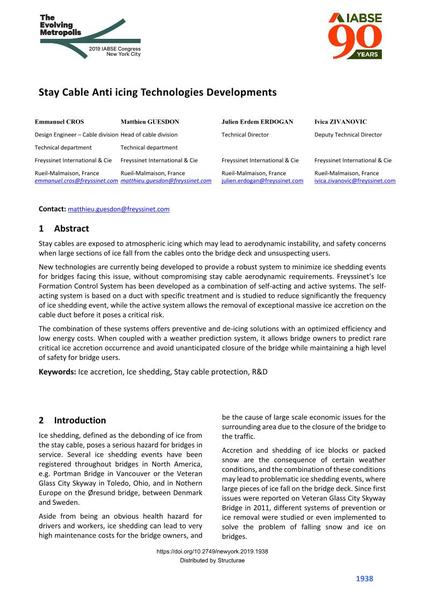Stay Cable Anti icing Technologies Developments

|
|
|||||||||||
Bibliografische Angaben
| Autor(en): |
Emmanuel Cros
(Freyssinet International & Cie)
Matthieu Guesdon (Freyssinet International & Cie) Julien Erdem Erdogan (Freyssinet International & Cie) Ivica Zivanovic (Freyssinet International & Cie) |
||||
|---|---|---|---|---|---|
| Medium: | Tagungsbeitrag | ||||
| Sprache(n): | Englisch | ||||
| Tagung: | IABSE Congress: The Evolving Metropolis, New York, NY, USA, 4-6 September 2019 | ||||
| Veröffentlicht in: | The Evolving Metropolis | ||||
|
|||||
| Seite(n): | 1938-1943 | ||||
| Anzahl der Seiten (im PDF): | 6 | ||||
| DOI: | 10.2749/newyork.2019.1938 | ||||
| Abstrakt: |
Stay cables are exposed to atmospheric icing which may lead to aerodynamic instability, and safety concerns when large sections of ice fall from the cables onto the bridge deck and unsuspecting users. New technologies are currently being developed to provide a robust system to minimize ice shedding events for bridges facing this issue, without compromising stay cable aerodynamic requirements. Freyssinet’s Ice Formation Control System has been developed as a combination of self-acting and active systems. The self- acting system is based on a duct with specific treatment and is studied to reduce significantly the frequency of ice shedding event, while the active system allows the removal of exceptional massive ice accretion on the cable duct before it poses a critical risk. The combination of these systems offers preventive and de-icing solutions with an optimized efficiency and low energy costs. When coupled with a weather prediction system, it allows bridge owners to predict rare critical ice accretion occurrence and avoid unanticipated closure of the bridge while maintaining a high level of safety for bridge users. |
||||
